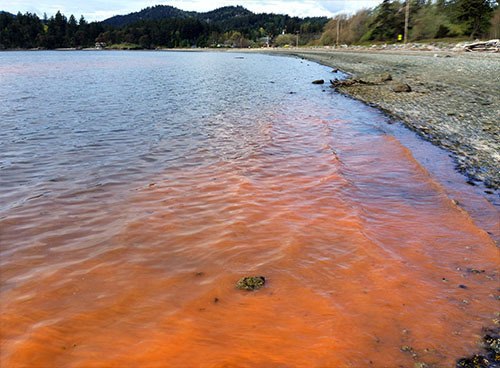The rusty waters of Crescent Beach may have made you want to call out, “red tide.”
Before you tell your friends, you should know red waters don’t always make for harmful situations. According to the National Oceanic and Atmospheric Administration, most blooms that create color in the water are beneficial because the tiny plants create food for animals in the ocean and can be the major source of energy that fuels the ocean food web.
“The red tide was 100 percent Noctiluca scintillans, a very colorful but largely harmless dinoflagellate,” said scientist Russel Barsh about the bright tide spotted at Crescent Beach in East Sound last week.
Barsh describes Noctiluca as basically a big transparent bag with a photosynthetic “heart” that can look not just red but also green or gold. At night, it engulfs diatoms and other algae and eats them.
For blooms that can cause problems, scientists actually prefer the term harmful algal bloom as opposed to red tide as to not confuse others.
According to NOAA, a small percentage of algae produce powerful toxins that can kill fish, shellfish, mammals, and birds, and may directly or indirectly cause illness in people. What makes the water toxic is not the color, but the species involved.
“You cannot tell what organisms are present from color alone – microscopic identification is required,” said Barsh.
What has been confusing for islanders who have investigated the recent red tide, is a website produced by the Washington State Department of Health showing that harvesting of all shellfish is banned in East Sound and butter and varnish clams only are banned throughout San Juan County at this time.
According to department officials this closure was from water samples taken in December and they will check the water again in May for updated information. Basically there is no information at this time from the Washington State Department of Health to indicate a harmful algal bloom.
For Barsh the real oddity of this colorful tide is that it was not expected until June or later this summer.
“The bloom was very early,” said Barsh. “And it is an indicator that we may be facing an El Nino summer.”




